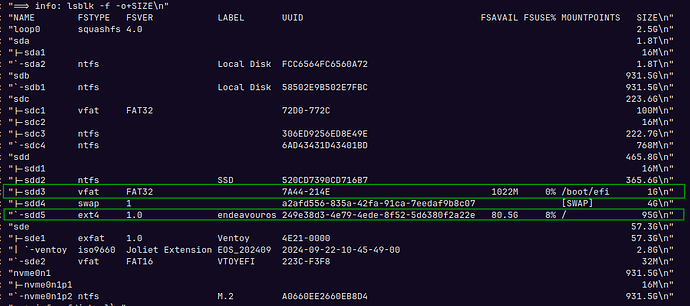I tried doing a non-ventoy install same result, but as for the efibootmgr entries, I found something interesting.
After I finished the install (without restarting) I could indeed see an entry for endeavouros.
I restarted, again couldn’t boot into EOS so I went back to the live image and running efibootmgr again, endeavouros is now gone and only the windows boot manager & USB entries are present.
Right after install:
[liveuser@eos-2024.09.22 ~]$ efibootmgr
BootCurrent: 0002
Timeout: 1 seconds
BootOrder: 0003,0000,0001,0002
Boot0000* Windows Boot Manager HD(1,GPT,ce155b01-b9e3-41e6-bc1a-dd0a2c6660e0,0x800,0x32000)/\EFI\MICROSOFT\BOOT\BOOTMGFW.EFI57494e444f5753000100000088000000780000004200430044004f0042004a004500430054003d007b00390064006500610038003600320063002d0035006300640064002d0034006500370030002d0061006300630031002d006600330032006200330034003400640034003700390035007d00000035000100000010000000040000007fff0400
Boot0001* UEFI: USB PciRoot(0x0)/Pci(0x1,0x2)/Pci(0x0,0x0)/USB(3,0)/CDROM(1,0x536b20,0x51040)0000424f
Boot0002* UEFI: USB, Partition 2 PciRoot(0x0)/Pci(0x1,0x2)/Pci(0x0,0x0)/USB(3,0)/HD(2,MBR,0x4a514722,0x536b20,0x51000)0000424f
Boot0003* endeavouros HD(1,GPT,f12e366d-268d-4a86-92d3-5819ec4ac5ac,0x22,0x1fffde)/\EFI\endeavouros\grubx64.efi
Restart right after install:
[liveuser@eos-2024.09.22 ~]$ efibootmgr
BootCurrent: 0002
Timeout: 1 seconds
BootOrder: 0000,0001,0002
Boot0000* Windows Boot Manager HD(1,GPT,ce155b01-b9e3-41e6-bc1a-dd0a2c6660e0,0x800,0x32000)/\EFI\MICROSOFT\BOOT\BOOTMGFW.EFI57494e444f5753000100000088000000780000004200430044004f0042004a004500430054003d007b00390064006500610038003600320063002d0035006300640064002d0034006500370030002d0061006300630031002d006600330032006200330034003400640034003700390035007d00000035000100000010000000040000007fff0400
Boot0001* UEFI: USB PciRoot(0x0)/Pci(0x1,0x2)/Pci(0x0,0x0)/USB(3,0)/CDROM(1,0x536b20,0x51040)0000424f
Boot0002* UEFI: USB, Partition 2 PciRoot(0x0)/Pci(0x1,0x2)/Pci(0x0,0x0)/USB(3,0)/HD(2,MBR,0x4a514722,0x536b20,0x51000)0000424f
I noticed that when rebooting, in the boot message things it’s saying that it’s failing to umount /run/archiso/bootmnt or /run/archiso/airootfs, not sure if that has anything to do with it.
